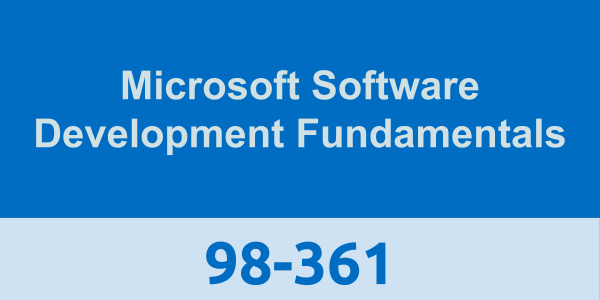Who should take this exam?
Microsoft Software Development Fundamentals Exam Summary:
| Exam Name | Microsoft Technology Associate (MTA) - Software Development Fundamentals |
| Exam Code | 98-361 |
| Exam Price | $127 (USD) |
| Exam Price | 45 mins |
| Number of Questions | 40-60 |
| Passing Score | 700 / 1000 |
| Books / Training | 40361A: Software Development Fundamentals: MTA Exam 98-361 (3 Days) 40035A: Software Development Fundamentals with .NET: Training 2-Pack for MTA Exams 98-361 and 98-372 (5 Days) 40034A: Software Development Fundamentals with HTML5: Training 2-Pack for MTA Exams 98-361 and 98-375 (5 Days) |
| Sample Questions | Microsoft Software Development Fundamentals Sample Questions |
| Practice Exam | Microsoft 98-361 Certification Practice Exam |
Microsoft 98-361 Exam Syllabus Topics:
| Topic (Weights) | Details |
| Understanding core programming (15-20%) | Understand computer storage and data types ◈ How a computer stores programs and the instructions in computer memory, memory stacks and heaps, memory size requirements for the various data storage types, numeric data and textual data Understand computer decision structures ◈ Various decision structures used in all computer programming languages; If decision structures; multiple decision structures, such as If…Else and switch/Select Case; reading flowcharts; decision tables; evaluating expressions Identify the appropriate method for handling repetition ◈ For loops, While loops, Do...While loops, and recursion Understand error handling ◈ Structured exception handling |
| Understanding object-oriented programming (20-25%) | Understand the fundamentals of classes ◈ Properties, methods, events, and constructors; how to create a class; how to use classes in code Understand inheritance ◈ Inheriting the functionality of a base class into a derived class Understand polymorphism ◈ Extending the functionality in a class after inheriting from a base class, overriding methods in the derived class Understand encapsulation ◈ Creating classes that hide their implementation details while still allowing access to the required functionality through the interface, access modifiers |
| Understanding general software development (15-20%) | Understand application life cycle management ◈ Phases of application life cycle management, software testing Interpret application specifications ◈ Reading application specifications and translating them into prototypes, code, select appropriate application type, and components Understand algorithms and data structures ◈ Arrays, stacks, queues, linked lists, and sorting algorithms; performance implications of various data structures; choosing the right data structure |
| Understanding web applications (15-20%) | Understand web page development ◈ HTML, Cascading Style Sheets (CSS), JavaScript Understand Microsoft ASP.NET web application development ◈ Page life cycle, event model, state management, client-side versus server-side programming Understand web hosting ◈ Creating virtual directories and websites, deploying web applications, understanding the role of Internet Information Services Understand web services ◈ Web services that will be consumed by client applications, accessing web services from a client application, SOAP and Web Service Definition Language (WSDL) |
| Understanding desktop applications (15-20%) | Understand Windows apps ◈ UI design guideline categories, characteristics and capabilities of Store Apps, identify gestures Understand console-based applications ◈ Characteristics and capabilities of console-based applications Understand Windows Services ◈ Characteristics and capabilities of Windows Services |
| Understanding databases (15-20%) | Understand relational database management systems ◈ Characteristics and capabilities of database products, database design, Entity Relationship Diagrams (ERDs), normalization concepts Understand database query methods ◈ Structured query language (SQL), creating and accessing stored procedures, updating data and selecting data Understand database connection methods ◈ Connecting to various types of data stores, such as flat file; XML file; in-memory object; resource optimization |
Note:
This preparation guide is subject to change at any time without prior notice and at the sole discretion of Microsoft. Microsoft exams might include adaptive testing technology and simulation items. Microsoft does not identify the format in which exams are presented. Please use this preparation guide to prepare for the exam, regardless of its format. To help you prepare for this exam, Microsoft recommends that you have hands-on experience with the product and that you use the specified training resources. These training resources do not necessarily cover all topics listed in the "Skills measured" section.





0 comments:
Post a Comment